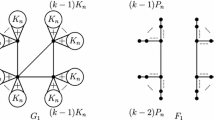Abstract
We denote by Leafy Spanning \(k\)-Forest the problem of, given a positive integer k and a graph G with at most k components, finding a spanning forest in G with at most k components and the maximum number of leaves. The case \(k=1\) is known to be NP-hard, and is well studied in the literature, with the best approximation algorithm having been proposed more than 20 years ago by Solis-Oba. The best approximation algorithm known for Leafy Spanning \(k\)-Forest is a 3-approximation based on an approach by Lu and Ravi for the \(k=1\) case. We extend the algorithm of Solis-Oba to achieve a 2-approximation for Leafy Spanning \(k\)-Forest.





Similar content being viewed by others
Data Availibility
Not applicable.
Code Availability
Not applicable.
References
Chellali M, Favaron O (2020) Connected domination. In: Haynes TW, Hedetniemi ST, Henning MA (eds) Topics in domination in graphs. Developments in mathematics, vol. 64, pp. 79–127. Springer
Chen H, Chen X, Tan X (2011) On \(k\)-connected restrained domination in graph. Ars Combin 98:387–397
Chlebík M, Chlebíková J (2008) Approximation hardness of dominating set problems in bounded degree graphs. Inform and Comput 206:1264–1275
Daligault J, Thomassé S (2009) On finding directed trees with many leaves. International Workshop on Parameterized and Exact Computation, Lecture Notes in Computer Science 5917:86–97
Feige U (1998) A threshold of \(\ln n\) for approximation set cover. J ACM 45(4):634–652
Fernandes CG, Lintzmayer CN (2020) Leafy spanning arborescences in DAGs. In Proceedings of the 14th Latin American Symposium on Theoretical Informatics (LATIN), Lecture Notes in Computer Science, vol. 12118, pp. 1–13
Galbiati G, Maffioli F, Morzenti A (1994) A short note on the approximability of the maximum leaves spanning tree problem. Inf Process Lett 52(1):45–49. https://doi.org/10.1016/0020-0190(94)90139-2
Garey MR, Johnson DS (1979) Computers and Intractability. W.H. Freeman and Co., New York
Guha S, Khuller S (1996) Approximation algorithms for connected dominating sets. In Proceedings of the 4th Annual European Symposium on Algorithms (ESA), Lecture Notes in Computer Science, vol. 1136, pp. 179–193
Hartnell BL, Vestergaard PD (2005) Dominating sets with at most \(k\) components. Ars Combin 74:223–229
Jüttner A, Magi A (2005) Tree based broadcast in ad hoc networks. Mobile Netw Appl 10(5):753–762
Kouider M, Vestergaard PD (2006) Generalized connected domination in graphs. Discrete Math Theor Compu Sc 8:57–64
Lu H, Ravi R (1998) Approximating maximum leaf spanning trees in almost linear time. J Algorithms 29(1):132–141
Min M, Du H, Jia X, Huang CX, Huang SCH, Wu W (2006) Improving construction for connected dominating set with Steiner tree in wireless sensor networks. J Global Optimization 35(1):111–119. https://doi.org/10.1007/s10898-005-8466-1
Pope J, Simon R (2015) Efficient one-to-many broadcasting for resource-constrained wireless networks. In Proceedings of the 40th Annual IEEE Conference on Local Computer Networks (LCN), pp. 518–525
Reis MF, Felice MCS, Lee O, Usberti FL (2017) A 3-approximation algorithm for the maximum leaf \(k\)-forest problem. Electron Notes Discrete Math 62:201–206
Solis-Oba R (1998) 2-approximation algorithm for finding a spanning tree with maximum number of leaves. In Proceedings of the 6th Annual European Symposium on Algorithms (ESA), Lecture Notes in Computer Science, vol. 1461, pp. 441–452
Solis-Oba R, Bonsma P, Lowski S (2017) A 2-approximation algorithm for finding a spanning tree with maximum number of leaves. Algorithmica 77:374–388
Zheng J, Jamalipour A (eds.) (2009) Wireless Sensor Networks: A Networking Perspective. John Wiley & Sons
Funding
C. G. Fernandes was partially supported by the National Council for Scientific and Technological Development – CNPq (Proc. 310979/2020-0 and 423833/2018-9). C. N. Lintzmayer was partially supported by CNPq (Proc. 312026/2021-8 and 428385/2018-4). This study was financed in part by the Coordenação de Aperfeiçoamento de Pessoal de Nível Superior - Brasil (CAPES) - Finance Code 001.
Author information
Authors and Affiliations
Corresponding author
Ethics declarations
Conflicts of interest
The authors have not disclosed any competing interests.
Additional information
Publisher's Note
Springer Nature remains neutral with regard to jurisdictional claims in published maps and institutional affiliations.
Rights and permissions
About this article
Cite this article
Fernandes, C.G., Lintzmayer, C.N. & San Felice, M.C. Leafy spanning k-forests. J Comb Optim 44, 934–946 (2022). https://doi.org/10.1007/s10878-022-00872-z
Accepted:
Published:
Issue Date:
DOI: https://doi.org/10.1007/s10878-022-00872-z




